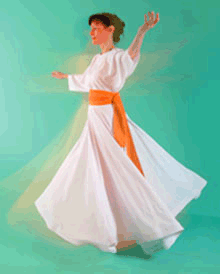DERVISH YOGA
THE SUFI SECRET OF ETERNAL YOUTH
Idris Lahore, Ennea Tess Griffith, Emma Thyloch
Dervish Yoga Book
Dervish Yoga for Health and Longevity details the Seven Major Arkanas of Samadeva Gestural Euphony, and also includes chapters on meditation, relaxation, and a special exercise for sexual health.
Clearly explained and illustrated by many detailed photographs,
the exercises can be easily learned in just 10 minutes a day.
Practicing Dervish Yoga brings innumerable benefits:
improved health, greater flexibility and coordination, inner calm, a clearer mind, a deeper relationship with our body, and a feeling of harmony within ourselves and with the world around us.
It is addressed to anyone of any age — from beginners with no previous experience in movement techniques, to alternative health practitioners and people in the helping professions, to seasoned instructors of yoga, tai chi, qi gong, dance, or other methods who want to acquire new experience and enrich their area of expertise; it is also for people who want to further their inner development, come into a closer relationship with their body, or simply free themselves from stress.
The book also includes chapters on
– “The Harmonization of the Chakras,”
– “Practical Tips for Optimizing Your Health,”
– “From Catharsis to Consciousness: Rediscovering the Connection between Body and Spirit,” – “Samadeva and Quantum Physics: Where Science Meets Wisdom,”
– and the incredible story of the origins of Dervish Yoga describing Idris Lahore’s first meeting with the Sufi sheikh of a secluded Dervish brotherhood in Kafiristan, where he was to learn the ancient movements that form the basis of Samadeva Gestural Euphony.
About the authors:
IDRIS LAHORE
has been immersed in both Eastern and Western cultures and spiritual traditions since his childhood. Over the course of his extensive travels and studies throughout the world – from China, Tibet, and India to Arabia, Persia, Palestine, and Egypt – he acquired a profound knowledge of the heart of these traditions and a subtle understanding of the human psyche. The author of many books translated into several languages, Idris Lahore has introduced Samadeva, the therapeutic art of the dervishes, to the West.
ENNEA TESS GRIFFITH
has practiced many psycho-corporal techniques since her earliest youth, including such eastern techniques as yoga, tai chi chuan, and qi gong and western techniques such as stretching, eurythmy, and Bothmer gymnastics. Trained in the healing techniques of the dervishes by Idris Lahore for over a decade, Ennea Tess Griffith has been working to make the ancient knowledge and practical methods of the dervishes accessible to the West. With Idris Lahore, she developed the nine branches of Samadeva taught at the Free University of Samadeva, of which she is the founder, directing many of the University’s seminars and courses. She teaches several introductory and advanced courses, particularly in Dervish Yoga (Samadeva Gestural Euphony), Lou Yong Zhi Neng, Meridian Energetic Techniques, and Family and Systemic Constellations.
EMMA THYLOCH
was trained by Idris Lahore in the psycho-corporal techniques of the dervishes, which she has taught for eleven years. Co-founder of the Free University of Samadeva, she teaches courses and seminars in Dervish Yoga, Nadi Yoga, and Gurdjieff Dances and Movements. In addition, she organizes classes and workshops throughout Europe. Emma Thyloch also teaches training courses in Euphonic and Energetic Massage, one of the nine branches of Samadeva.
The Seven Major Arkanas of Samadeva Gestural Euphony

Thanks to Idris Lahore, the art, philosophy, and science of the movements of Samadeva – as it has been practiced by the dervishes in their secret brotherhoods since the most ancient times – is now accessible to the West.
The movements of Samadeva are similar to yoga, tai chi chuan, and dance. Following a rigorous training, described in the book, Idris Lahore was authorised to transmit the knowledge and techniques of the dervishes to the men and women of the West. After many years of intense work under the tutelage of Idris Lahore, his students Ennea Tess Griffith and Emma Thyloch teach Samadeva in courses given in France and abroad, as well as at the Free University of Samadeva located in Alsace.
In this book you will discover the seven fundamental Arkanas (secret exercises) of Samadeva,
known by the dervishes as “exercises of rejuvenation.”
They are simple, extraordinarily revitalising, and fortify the body, bringing it health, energy, flexibility, and relaxation.
They reharmonise the psyche, slow the aging process, and regenerate the mind, rendering it sharper and clearer. These truly remarkable exercises stimulate and harmonise all of our physical, emotional, and mental resources, helping us to become more at peace, more joyful and creative in the face of all the situations of our daily lives. Vividly portrayed in numerous detailed, full-color photographs, the exercises are explained here both simply and effectively.
Philosophy, poetry, art, psychology, science, medicine, health, personal development, and spirituality all come together in this book in a living way. A basic work for everyone, from beginners to professional therapists.
Rumi and the Soul of the Goddess Samadeva
In his time, Rumi was considered to be the greatest poet, philosopher, and scholar of the Persian language; but up until then, his religious puritanism had prevented him from becoming interested in the apparently more superficial manifestations of art, like music, dance, and song.
One day he was walking through the streets of Konya when he saw a man dancing the Sama, the whirling dance of the dervishes. It was Shamz of Tabriz, who was to become his Master. Watching Shamz turn and practice his dancing exercises, Rumi fell into a state of ecstasy. He then had the following extraordinary vision: while Shamz was turning, Rumi saw a dancer step out of his body and rise toward the heavens, and he knew that this was the soul of Shamz.
From this moment dates Rumi’s conversion to the whirling dance of the dervishes, which he was later to make the very heart of his teaching. Rumi’s state of ecstasy lasted so long that by the time it had ended, Shamz had already disappeared. Distraught, Rumi went out in search of him. He walked the alleyways of the souk, one after the other, and passing by a goldsmith’s shop, heard the crystalline patter of a tiny hammer tapping on gilded metal. He entered the shop and perceived, beside the goldsmith, a young girl hammering an object she was holding in her hands. Coming closer, Rumi saw that she was sculpting a dancer, the perfect replica of the dancer he had recognised earlier as the soul of Shamz of Tabriz.
Once again, Rumi fell into ecstasy and felt his own soul as it, too, began to whirl. He who had never danced before, who had never practiced the Sama, began whirling in the goldsmith’s shop. For the first time, he recognised his own soul, which, like the soul of Shamz, rose from his body, lifting him up toward the heavens.
After the state of ecstasy had come to an end, Rumi remained for a time with the goldsmith and his daughter. He learned that she was sculpting the dancer Samadeva, one of the Hindu goddesses of the dance
According to the legend of Samadeva, the human soul is naturally beautiful and joyous, but imprisoned, as it were, in the physical body with all its limitations and illnesses, and prisoner also of many negative and conflictual emotions.
The Samadeva dances and exercises liberate this soul.
Man’s thoughts become clear, his emotions positive, and his body young and healthy once again.
Such is the tale of the dancer Samadeva, recognised as the goddess of the dance by the wandering dervishes, the Malamati dervishes of South India, the brotherhood to which Shamz of Tabriz belonged. The mystical dancers say that by turning, by practicing these dances, the dancer is united with the soul of the dance, with the goddess of the dance, with Samadeva.
————
– Dervish Yoga
– Language: French
– Format : 170 x 250 mm , 200 pages, 368 color illustrations,
– ISBN : 2-35195-004-6,
– Collection Health and Well-Being
– Complete English translation available for foreign rights
– Rights sold : English, German, Dutch, Russian, Polish, Croatian
– Editions EccE
– A selection of Buddhachannel.tv




